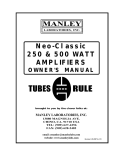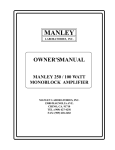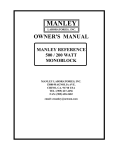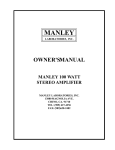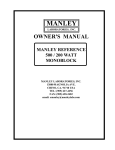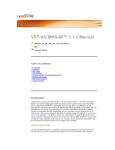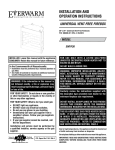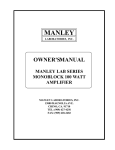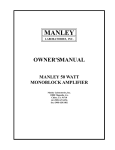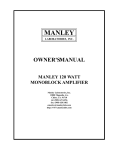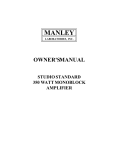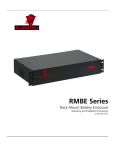Download Manley MONOBLOCK AMPLIFIER Owner`s manual
Transcript
MANLEY LABORATORIES, INC. OWNER'S MANUAL MANLEY NEO-CLASSIC 250 / 100 WATT MONOBLOCK AMPLIFIER MANLEY LABORATORIES, INC. 13880 MAGNOLIA AVE. CHINO, CA. 91710 TEL: (909) 627-4256 FAX: (909) 628-2482 REV. 3-10-2001 CONTENTS SECTION PAGE INTRODUCTION 3 MAINS CONNECTIONS 4 CONNECTING YOUR AMPLIFIER 5 TOP, REAR, FRONT VIEW OPERATIONAL NOTES 6,7,8 9 BIAS PROCEDURE 10 REPLACING TUBES 11 TROUBLESHOOTING 12 SPECIFICATIONS 13 WARRANTY 14 WARRANTY REGISTRATION 15 INTRODUCTION THANK YOU!... for choosing the Manley Neo-Classsic 250/100 Monoblock Amplifiers. The Manley 250/100 Monoblock Amplifiers use only the best available components, with the shortest and cleanest signal path possible, and with the use of our own in-house CNC machine shop we can provide you with a amplifier that looks as good as it sounds. The circuit and the components used have been chosen carefully after years of development and refinement for reliability, constancy and most importanly, musical, accurate, and emotional delivery of the sound. The circuit topology is similar to other designs in the MANLEY range. This amplifier is configured to switch between triode or tetrode operation which allows the user to choose between the sonic benefits and seductive qualities of triode and the more powerful tetrode operation mode. We emphasize big, beefy reservoir capacitors in the high voltage supplies giving plenty of instant energy for dynamic performance of transient peaks and bass performance which often exceeds that of rival solid-state amplifiers. We run high voltages on the plates of the output tubes and are thus able to run them at lower current which will result in longer life for the output tubes, and careful use of the 'EVER-WARM' power switching should also greatly increase the life of the output tubes as well as allowing your amplifiers to always be ready for pleasurable listening. Each output tube has its own bias adjust, and the procedure for adjusting each tube's current draw is described in this manual. The output transformer is a revolutionary new design which is wound on the Manley Labs factory premesis. Its stellar performance will be obvious upon first listening. The secret is in keeping both phases of the push-pull halves always equal in resistance, inductance capacitance, and in this new output transformer design that goal is met. The output transformer has been factory set for an optimum 5 ohm load which the optimum compromise to drive most speakers.. Thank you again, and please enjoy! GENERAL NOTES LOCATION & VENTILATION The Manley Neo-Classic 250/100 Monoblock Amplifiers must be installed in a stable location with ample ventilation. Allow a minimum of 2 inches of clearance on the top and sides of the amplifiers, such that a constant flow of air can flow. Do not place amplifiers directly on high pile carpet or any other surface that will block the ventilation vents underneath the amplifiers. If you have small children or pets, you should consider placing the amplifiers out of reach to prevent damage to the amplifier or damage to your small children or pets by the amplifier as the tubes do get hot during operation. WATER & MOISTURE As with any electrical equipment, these amplifiers should not be used near water or moisture. If liquid enters the amplifier, it must be immediately returned to your dealer for servicing. SERVICING The user should not attempt to service the amplifier beyond that described in the owner's manual. Refer all servicing other than biasing and tube replacement to Manley Laboratories SPECIAL NOTES Tubes may become loose during transit. Straighten and press down each tube before plugging the amplifier into the mains socket. Furthermore, do not touch the tubes after the amplifier has been switched on, as the tubes become very hot during operation and should only be handled after the power has been turned off and the tubes have cooled. WARNING! ! TO PREVENT THE RISK OF ELECTRIC SHOCK DO NOT OPEN THE CABINET REFER SERVICING TO QUALIFIED PERSONEL 3 MAINSCONNECTIONS Your amplifier has been factory set to the correct mains voltage for your country. The voltage setting is marked on the serial badge, located on the rear panel. Check that this complies with your local supply. Export units for certain markets have a moulded mains plug fitted to comply with local requirements. If your unit does not have a plug fitted the coloured wires should be connected to the appropriate plug terminals in accordance with the following code. GREEN/YELLOW BLUE BROWN EARTH NEUTRAL LIVE terminal terminal terminal As the colours of the wires in the mains lead may not correspond with the coloured marking identifying the terminals in your plug proceed as follows; The wire which is coloured GREEN/YELLOW must be connected to the terminal in the plug which is marked by the letter E or by the safety earth symbol or coloured GREEN or GREEN and YELLOW. The wire which is coloured BLUE must be connected to the terminal in the plug which is marked by the letter N or coloured BLACK. The wire which is coloured BROWN must be connected to the terminal in the plug which is marked by the letter L or coloured RED. DO NOT CONNECT/SWITCH ON THE MAINS SUPPLY UNTIL ALL OTHER CONNECTIONS HAVE BEEN MADE. 4 CONNECTING YOUR AMPLIFIER Setting up your amplifiers is rather easy. 1. Connect all source components (turntable, CD, Tuner, Tape DAT, etc.) to your preamplifier. 2. Connect the interconnects from the output of the preamplifier or switching center to the RCA input on the top rear of the amplifiers. IF your source has a truly BALANCED output, connect TO the XLR input and select the balanced input. This switch is a locking type to prevent inadvertant or accidental switching (say, while cleaning). To engage this switch, PULL OUT the toggle then gently switch the toggle. Do not force the switch to engage or you may break it. If using a standard UNBALANCED source, select and use the unbalanced RCA connector. This amplifier will not function properly if you are using the wrong input for your application. The XLR input is wired PIN1 GROUND, PIN 2 POSITIVE, PIN 3 NEGATIVE PHASE. 3. Connect the hot or "+" speaker cable to the red binding post and the common or "-" speaker cable to the black binding post (See diagarm 2). Ensure that the other end of the cable is connected correctly to the speaker. Tighten the binding posts by hand. If you use a nut-driver (3/8") do not over-tighten the posts or you may break the connections inside the amplifier. 4. Ensure that the "mains" switch on the front panel is in the "off" or "0" position and the OPERATE / STANDBY switch is in the STANDBY mode. 5. Turn on Preamplifier and any source components you plan to use. 6. Plug amplifier into wall outlet. 7. Switch the square mains power switch to the ON position and allow the amplifier a minute or so to 'warm up'. The blinking LED will indicate that the amplifier is in STANDBY mode. 8. Engage the soft-start swich to the OPERATE position. The blinking standby LED will extinguish. 9. Turn up the volume and enjoy. 10. After your listening session, if you wish to leave the amplifier in the energysaving and 'EVER-WARM' STANDBY mode, engage the OPERATE/ STANDBY switch to the STANDBY position. The standby blinking LED will remind you that the amplifier is in STANDBY mode. 5 OVERHEAD VIEW INPUT INPUT BAL/UNBAL. B+, & MAINS IEC MAINS IN FUSES XLR RCA SWITCH OUTPUT 3 1 2 4 12BH7 12BH7 10 8 6 5 7 9 12AT7 Tube Location & Type OUTPUT TUBES:10 x EL34 The EL34 types we recommend are the Sovtek EL34G, EL34G+, EL34WXT, or the Electro-Harmonix EL34EH . These have been proven to be the most rugged, reliable, and best sounding for these amplifers and we strongly emphasize that only these types should be used in this amplifier. The MANLEY NEO-CLASSIC 250/100 WATT MONOBLOCK has been thoroughly optimised around this tube. Use of unapproved tube types can and will void your warranty. We have selected the tubes for equality of current draw in our custom-built computerized tube tester for each of your monoblocks . Although each tube bias can be individually adjusted, "matched" tubes as we have selected are thouroughly beneficial to the amplifier's performance. DRIVER TUBES: 2 x 12BH7A The driver is the Yugoslavian EI 12BH7A or its equivalent,the American 12BH7,12BH7A, or 6414. INPUT TUBE: 12AT7WA The 12AT7WA has several equivalent numbers, (12AT7, 12AT7A, 6201, ECC81, etc.) Any of these types may be used. We have selected this 12AT7WA very carefully for noise, microphonics, and constancy. Replacement tubes of premium quality are always available from MANLEY LABORATORIES. 6 REAR VIEW ce N9512422 MAINS IN IEC MAINS B+ FUSE FUSE SLO-BLO SLO-BLO BALANCED UNBALANCED SWITCH 7 RCA XLR INPUT BALANCED INPUT SPEAKER OUTPUT BINDING POSTS FRONT VIEW MANLEY 250 TRIODE MUTE TETRODE 1 2 3 4 5 6 7 8 9 10 GROUND FRONT VIEW OF AMPLIFIER WITH INSERT REMOVED OPERATE STANDBY EVER-WARM SOFT START SWITCH SHOWING BIAS MEASUREMENT POINTS AND BIAS ADJUST POINTS 8 MAINS POWER ON / OFF SWITCH OPERATIONAL NOTES SWITCHING ON -- SOFT START The MANLEY NEO-CLASSIC 250/100 is equipped with a SOFT-START circuit which lessens the initial stress the amplifier takes upon turn-on. We recommend that you use this soft start facility whenever you turn the amplifier on and especially when cold. 1. Ensure that the "mains" switch on the front panel is in the "off" or "0" position and the OPERATE / STANDBY switch is in the STANDBY mode. 2. Turn on preamplifiers and all source components you plan to use and let them warm up for a minute. 3. Switch the square mains power switch to the ON position and allow the amplifier a minute or so to 'warm up'. The blinking LED will indicate that the amplifier is in STANDBY mode. 4. Engage the soft-start swich to the OPERATE position. The blinking standby LED will extinguish. 5. Turn up the volume and enjoy. THE EVER-WARM MODE After your listening session, if you wish to leave the amplifier in the energy-saving and 'EVERWARM' STANDBY mode, engage the OPERATE/STANDBY switch to the STANDBY position. The standby blinking LED will remind you that the amplifier is in STANDBY mode. The amplifier will draw only 400mA (30 watts @120VAC) from the mains outlet-- certainly an energy saving way to keep your amplifiers always ready to listen to! TRIODE / TETRODE OPERATION: With the TRIODE / TETRODE switch, the amplifier may be set for TRIODE or TETRODE operation. When the switch is in the lower position, the amplifier is in TETRODE mode which will produce well over 250 watts. When the switch is in the upper position, the amplifier is in TRIODE mode which will produce half the power of TETRODE operation but as fans of triodes know, nothing can match that sweet seductive sound of triodes! For some more demanding energetic music, large rooms, or for power hungry inefficient loadspeakers, you might find you will need the extra power of tetrode operation. Other times and other situations will find you very well satisfied with the triode mode. One major rule applies for switching between triode and tetrode: THE AMPLIFIER MUST BE TURNED OFF BEFORE SWITCHING BETWEEN TRIODE AND TETRODE!!!! Follow turn on SOFT START procedure above when re-powering up the unit. TUBE LIFE You should expect extended life from the tubes in your MANLEY 250/100 if you adhere to the procedures described above and check your bias at least once every 2-3 months. We stock all the tubes in these amplifiers should you ever need replacements (and at very reasonable prices too!) FUSES The fuses used in your amplifier are standard 1/4" x 1 1/4" SLO-BLO Ceramic types. The correctly rated fuse has been installed at the factory for your country's voltage. If replacing a fuse, always unplug the amplifier's power cord from the wall outlet and always use the exact same type and ampere rating fuse as the one you are replacing. Failure to do so will void your warranty and can be a dangerous fire hazard. NEVER replace a fuse with thick wire, tin foil, gum wrappers, or anything else other than the correct fuse! 9 BIAS PROCEDURE The Manley 250/100 Monoblock Amplifier uses a fixed bias system that requires very little attention. The term "bias" as used here refers to an externally adjustable voltage applied to each of the output tubes. This voltage setting optimizes the operation of the tubes; proper adjustment ensures the best sonic performance and longest tube life. We recommend that this adjustment be performed upon initial receipt of the amps, and every 2-3 months thereafter. For this procedure you will need a voltmeter (a hand held autoranging DMM digital multimeter is the easiest), a 3/32" allen key, and a small 1/8" flat screwdriver. 1. Remove the four silver hex cap head screws which secure the insert to the faceplate. Also then remove by hand, the two knurled black decorative nuts on the Triode and SoftStart switches. On page 8, which shows the FRONT panel of the amplifier, you can see 10 red tip jacks plus the ground point. To measure the current draw of each output tube place the POSITIVE meter probe into the first red tip jack. (If you read a negative reading reverse the meter probes, no harm will be done.) Set the meter to read 'millivolts' DC (direct current). 2. Each of the ten output tubes can have its own bias adjusted by adjusting its own bias adjust pot. Above the measurement tip jacks you can see each tube's bias adjust pot. 3. The first step to setting the bias is to turn on the amplifier in triode mode and ensure that there is zero signal input, either leave the preamplifier or source signal turned off or unplug the amplifier input. Also, leave your loudspeakers connected as these provide an ideal load on the output. (DO NOT EVER OPERATE YOUR AMPLIFIER WITHOUT SPEAKERS CONNECTED!) It is recommended that you leave the amplifier on long enough to ensure that the tubes have reached their stable current draw, at least 1/2 hour is recommended. 5. Place the meter probes in the first red tip jack . Adjust the first bias trim pot slowly until you measure 275mV to 285 mVDC (0.275V to 0.285VDC). Since you are measuring across a 10 ohm cathode resistor, this would correspond to a 27 to 28 mA current draw for each tube by Ohm's law. A reading of 0mV can indicate a failed tube, or an open cathode resistor. A reading of 0mV on ALL tubes (powered on condition) can mean the B+ fuse has blown. The cause of this should be investigated before simply putting a new fuse in. 6. If an individual tube cannot be adjusted to at least 250mv, or it cannot be adjusted below 300mv, then replacement is probably indicated (also see "Troubleshooting"). 7. Follow step five with the remaining tubes, switching to the next tube point and adjusting the next trim pot each time. After you have adjusted all the output tubes, recheck and repeat the procedure as they will drift a little bit during adjustment. Once they are all set, your amplifier should be in perfect operation. ( BIAS IN TETRODE MODE SHOULD READ 270mV TO 310mV. THERE IS A MASTER BIAS ADJUSTMENT TRIMPOT INSIDE THE UNIT, THIS TRIMPOT IS FACTORY SET ). 10 REPLACING TUBES (Also refer to page 6) How long will these tubes last? We can't say for sure. Some die prematurely and some tubes last more than 30 years. The average for the tubes in the 250 seems to be 4 to 5 years depending on useage. As with all tubes, their quality degrades with age. This is due to decreasing cathode emission, a natural process found in all tubes. How can I tell when I need to replace them? Most problems relating to the output tubes will show up while performing the bias procedure (see page 9). Tubes that cannot be adjusted within the specified range or have a very unstable reading are candidates for replacement. If the tube's plate (the metal rectangular boxlike part most visible from the outside) is glowing cherry red or orange, then the tube is severely overheated. Check it's bias immediately; if unable to adjust, then turn off the amplifier right away and replace the tube. The preamp and driver tubes can become noisy (hiss) or the amplifier may exhibit audible distortion; substituting known good tubes is the best way find the bad one. All tubes are "microphonic" to some extent- that is, they will make ringing noises through the speakers when tapped or vibrated. Here again, substitution will detrmine which one is excessive. Obviously, any tube that is totally dark inside while powered up or is cold to the touch (careful!) is defective. Most tubes have a silvery coating deposited on some area inside the glass bottle. If this has turned white (compare to another tube), then the tube has lost vacuum (or gained air!) and is definitely bad. Replace at once- don't turn the amp on. Do I need to replace them all at once? No, at least not with these amps. Some tube amps do require that if one tube has to be replaced that a complete matched set put in. All Manley amps use individual bias trims for each output tube which allows a single tube to be replaced. Absolute best performance is achieved when the tubes are most similar. We batch them and label each tube so that in the event of a replacement you can get one from Manley of similar characteristics as the others in your amp. We need that hand written number on the top of the tube (output tubes only). Does the "sound" of the amp change as the tube ages? Yes, but not very much. It is just the tubes and they can be replaced. It is not like big guitar amps where tubes are replaced every 6 months for reasons of "tone". We run the tubes quite conservatively which allows a very long life and less change between old and new tubes. This is where that 4 to 5 years of use comes from. You may notice an improvement between tubes this old and new tubes depending on how critical you are. Keep in mind the sound of new tubes changes most in the first weeks of use before they can be considered "broken in". At first the sound may be a little "tight" and "direct". Is it difficult to replace a tube? Yes, if you have trouble replacing light bulbs. It is super easy. Turn off the power. Just let the amp cool a few minutes so that you don't burn your pinkies. It helps to wiggle the tube gently rather than pulling it out straight. Even if you don't consider yourself "technical" you probably have more technical ability than your parents and they used to fix the family TV set by taking out the tubes and putting them on the tube tester at the local pharmacy. It is almost as easy to re-insert a tube. Just make sure it is correctly lined up with the socket and you dont bend a pin. You can wiggle it in too. If you had a solid state amp, it would be an unlikely repair. You would have to open it up, diagnose the bad transistors and burnt resistors, de-solder, find replacements (good luck) re-solder, and hold your breath as you turn it on. Or you could send it back, be without music for a few weeks, pay for service by the hour and get real upset when it fries again. If one transistor goes the system is dead, not so with power tubes, just limping. If you need a tube or set of tubes Manley will be happy to sell you some (matched) at a good price and if you prefer to sent the unit back for repair or adjustment, our warranty covers about everything except tubes (6 mo. only) and abuse and we handle ground shipping back to you - usually the same week. 11 TROUBLESHOOTING It is rare that any of these problems occur but if they do here is some things to try. HUM - Try a mains ground adapter if they are legal in your country. They are also called 3 pin to 2 pin adapters or "cheaters" and are available in hardware stores. There should be one ground in your system and only one. If two or more pieces of gear have 3 pin AC cables a ground loop can occur which will usually cause hum. The preamplifier is probably the best grounded single piece as it is the center of your system. HISS - With the power turned off , disconnect the input to the 250. Now turn it back on (remember to first power up in "soft-start") and listen. Did the hiss stop? If so, then the source of the hiss is something other than the 250. If ithe noise level is the same, then the problem is in the 250- probably a bad 12AT7. Exchange the tube for a known good one. BALANCE - The two speakers sound different - It may be the CD or source and the way it was recorded. First try a different source. Next try swapping the inputs. Power down and swap left and right inputs. If it is the source, then the problem will "follow" the swap. Return them to normal (L=L). Power down again and next try swapping the speaker connections by putting the left speaker wire in the right terminals and right wires into the left terminals. If the problem switched sides then one 250 is suspect; if the problem stayed on the same side it is probably a damaged or fatigued speaker. NO SOUND, NO PILOT LIGHT, TUBES DARK- Check AC Mains fuse on back panel. Check AC power cord. Is the amp plugged into a working electrical outlet? (this has happened to everyone at least once). NO SOUND , PILOT LIGHT ON, TUBES LIT- Check speaker connection and input connection (exchange with the other channel). Take a bias measurement- do all bias test points read zero volts? If so, B+ fuse is blown. CAREFULLY INSPECT ALL OUTPUT TUBES BEFORE REPLACING FUSE (see also "Replacing Tubes"). ONE OUTPUT TUBE WILL NOT BIAS- If the bias voltage one one tube will not adjust at all or reads zero volts, first replace the tube. If the reading still is way off or reads zero, turn the amplifier off. Set your multimeter to "ohms" instead of "DC volts". Now measure the bias test point- it should read approximately 10 ohms. If it reads very high or not at all, then the 10 ohm cathode resistor connected to the tube is burned open.This resistor is the final safety valve in case of a shorted output tube, and prevents damage to the rest of the amplifier should this occur. Replacing this resistor can be done by anyone with adequate soldering skills; we recommend contacting our service department here at the factory for specific instructions. 12 SPECIFICATIONS Vacuum Tubes: Output Power 10 x EL34 (Output), 2 x 12BH7A (Driver), 1 x 12AT7 (Input) TETRODE: 250 Watts (@1.5% THD 5 ohm load) TRIODE: 100 Watts (@1.5% THD 5 ohm load) Frequency Response, +/- .5 dB 10 Hz - 80 KHz Input Sensitivity 1V Input Impedance 100 KOhm Load Impedance 5 Ohm (fixed) S/N Ratio @250W -80 dB Power Consumption 30 Watts Quiescent (STANDBY MODE) 815 Watts Full Power (@1.5% THD 5Ω load) Mains Fuse 100, 110, 120 VAC : MDA10 A (250V) Slow-Blow (CERAMIC) 220, 230, 240 VAC: MDA 8 A (250V) Slow-Blow (CERAMIC) B+ Fuse MDA1 1/2 A (250V) Slow-Blow (CERAMIC) Dimensions W=19, D=13, H=11 inches Shipping Weight 76 lbs EACH 13 WARRANTY All Manley Laboratories equipment is covered by a limited warranty against defects in materials and workmanship for a period of 90 days from date of purchase to the original purchaser only. A further optional limited 5 year warranty is available to the original purchaser upon proper registration of ownership within 30 days of date of first purchase. Proper registration is made by filling out and returning to the factory the warranty card attached to this general warranty statement, along with a copy of the original sales receipt as proof of the original date of purchase. Only 1 card is issued with each unit, and the serial number is already recorded on it. If the warranty registration card has already been removed then this is not a new unit, and is therefore not warranted by the factory. If you believe this to be a new unit then please contact the factory with the details of purchase. This warranty is provided by the dealer where the unit was purchased, and by Manley Laboratories, Inc. Under the terms of the warranty defective parts will be repaired or replaced without charge, excepting the cost of tubes. Tubes are warranted for six months provided the warranty registration is completed as outlined in paragraph 1. If a Manley Laboratories product fails to meet the above warranty, then the purchaser's sole remedy shall be to return the product to Manley Laboratories, where the defect will be repaired without charge for parts and labour. The product will then be returned via prepaid, insured freight, method and carrier to be determined solely by Manley Laboratories. All returns to the factory must be in the original packing, (new packing will be supplied for no charge if needed), accompanied by a written description of the defect, and must be shipped to Manley Laboratories via insured freight at the customer's own expense. Charges for unauthorized service and transportation costs are not reimbursable under this warranty, and all warrantees, express or implied, become null and void where the product has been damaged by misuse, accident, neglect, modification, tampering or unauthorized alteration by anyone other than Manley Laboratories. The warrantor assumes no liability for property damage or any other incidental or consequental damage whatsoever which may result from failure of this product. Any and all warrantees of merchantability and fitness implied by law are limited to the duration of the expressed warranty. All warrantees apply only to Manley Laboratories products purchased and used in the USA. Some states do not allow limitations on how long an implied warranty lasts, so the above limitations may not apply to you. Some states do not allow the exclusion or limitation of incidental or consequential damges, so the above exclusion may not apply to you. This warranty gives you specific legal rights and you may also have other rights which vary from state to state. 14 WARRANTYREGISTRATION We ask that you please fill out this registration form and send the bottom half to: MANLEY LABORATORIES REGISTRATION DEPARTMENT 13880 MAGNOLIA AVE. CHINO CA, 91710 Registration entitles you to product support, full warranty benefits, and notice of product enhancements and upgrades. You MUST complete and return the following to validate your warranty and registration. Thank you again for choosing Manley Laboratories. MODEL ____________________ SERIAL No. ______________________ PURCHASE DATE ______________ SUPPLIER ______________________ --------------------------------------------------------------------------------------------------PLEASE DETACH THIS PORTION AND SEND IT TO MANLEY LABORATORIES MODEL: MANLEY NEO-CLASSIC 250/100 MONOBLOCK SERIAL No. ______________________________ PURCHASE DATE ______________ SUPPLIER _______________________ NAME OF OWNER _______________________________________________ ADDRESS ______________________________________________________ CITY, STATE, ZIP ________________________________________________ TELEPHONE NUMBER ___________________________________________ Comments???? ___________________________________________________ ________________________________________________________________ 15















